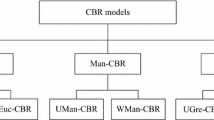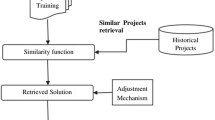Abstract
In recent years, grey relational analysis (GRA), a similarity-based method, has been proposed and used in many applications. However, we found that most traditional GRA methods only consider nonweighted similarity for predicting software development effort. In fact, nonweighted similarity may cause biased predictions, because each feature of a project may have a different degree of relevance to the development effort. Therefore, this paper proposes six weighted methods, including nonweighted, distance-based, correlative, linear, nonlinear, and maximal weights, to be integrated into GRA for software effort estimation. Numerical examples and sensitivity analyses based on four public datasets are used to show the performance of the proposed methods. The experimental results indicate that the weighted GRA can improve estimation accuracy and reliability from the nonweighted GRA. The results also demonstrate that the weighted GRA performs better than other estimation techniques and published results. In summary, we can conclude that weighted GRA can be a viable and alternative method for predicting software development effort.





















Similar content being viewed by others
Notes
Software development effort can be further used to estimate software development cost. Therefore, the terms “software effort” and “software cost” are generally used in other studies in this field.
References
Agrawal, M., & Chari, K. (2007). Software effort, quality, and cycle time: A study of CMM level 5 projects. IEEE Transactions on Software Engineering, 33(3), 145–156.
Auer, M., Trendowicz, A., Graser, B., Haunschmid, E., & Biffl, S. (2006). Optimal project feature weights in analogy-based cost estimation: Improvement and limitations. IEEE Transactions on Software Engineering, 32(2), 83–92.
Benediktsson, O., Dalcher, D., Reed, K., & Woodman, M. (2003). COCOMO-based effort estimation for iterative and incremental software development. Software Quality Journal, 11(4), 265–281.
Boehm, B. (1981). Software engineering economics. Englewood Cliffs: Prentice Hall.
Boehm, B., Clark, B., Horowitz, E., & Westland, C. (1995). Cost models for future software life cycle processes: COCOMO 2.0. Annals of Software Engineering, 1(1), 57–94.
Briand, L. C., Langley, T., & Wieczorek, I. (2000). A replicated assessment and comparison of common software cost modeling techniques. In Proceedings of the 22nd international conference on software engineering (ICSE 2000), Limerick, Ireland (pp. 377–386).
Chen, Z., Menzies, T., Port, D., & Boehm, B. (2005). Finding the right data for software cost modeling. IEEE Software, 22(6), 38–46.
Chiu, N. H., & Huang, S. J. (2007). The adjusted analogy-based software effort estimation based on similarity distances. Journal of Systems and Software, 80(4), 628–640.
CMMI Product Team. (2002). Capability maturity model integration, Version1.1. CMMI–SW/SE/IPPD/SS, staged representation, CMU/SEI-2002-TR-011.
Conte, S. D., Dunsmore, H. E., & Shen, V. Y. (1986). Software engineering metrics and models. Benjamin: Cummings Publishing Company.
Cuadrado-Gallego, J., Fernández-Sanz, L., & Sicilia, M. Á. (2006). Enhancing input value selection in parametric software cost estimation models through second level cost drivers. Software Quality Journal, 14(4), 339–357.
Deng, J. L. (1982). Control problems of grey systems. Systems and Control Letters, 1(5), 288–294.
Deng, J. L. (1989). Introduction to grey system theory. The Journal of Grey System, 1(1), 1–24.
Deng, J. L. (2000). Theory and approach of grey system. Taipei: Taipei Cau Lih Inc. (in Chinese).
Desharnais, J. M. (1989). Analyse statistique de la productivitie des projets informatique a partie de la technique des point des fonction. Masters Thesis, University of Montreal, QC.
Dolado, J. J. (2001). On the problem of the software cost function. Information and Software Technology, 43(1), 61–72.
Ejiogu, L. O. (2005). Software metrics: The discipline of software quality (1st ed.). North Charleston: BookSurge.
Fenton, N. E., & Pfleeger, S. L. (1998). Software metrics: A rigorous and practical approach (2nd ed.). Boston, MA: PWS Publishing.
Foss, T., Stensrud, E., Kitchenham, B., & Myrtveit, I. (2003). A simulation study of the model evaluation criterion MMRE. IEEE Transactions on Software Engineering, 29(11), 985–995.
Freedman, D., Pisani, R., & Purves, R. (1997). Statistics (3rd ed.). New York: W. W. Norton.
Hogg, R. V., & Craig, A. T. (1995). Introduction to mathematical statistics (5th ed.). Englewood Cliffs: Prentice Hall.
Hsu, C. J., & Huang, C. Y. (2006). Comparison and assessment of improved grey relation analysis for software development effort estimation. In Proceedings of the 3rd international conference on management of innovation and technology (ICMIT 2006), Singapore (pp. 663–667).
Hsu, C. J., & Huang, C. Y. (2007). Improving effort estimation accuracy by weighted grey relational analysis during software development. In Proceedings of the 14th Asia-Pacific software engineering conference (APSEC 2007), Nagoya, Japan (pp. 534–541).
Huang, S. J., & Chiu, N. H. (2006). Optimization of analogy weights by genetic algorithm for software effort estimation. Information and Software Technology, 48(11), 1034–1045.
ISBSG, International Software Benchmark and Standards Group. (2006). Data repository 8, 2006, www.isbsg.org.
Jeffery, R., Ruhe, M., & Wieczorek, I. (2000). A comparative study of two software development cost modeling techniques using multi-organizational and company-specific data. Information and Software Technology, 42(14), 1009–1016.
Jeffery, R., Ruhe, M., & Wieczorek, I. (2001). Using public domain metrics to estimate software development effort. In Proceedings of the 7th international symposium on software metrics (METRICS 2001), London, UK (pp. 16–27).
Jørgensen, M., Indahl, U., & Sjøberg, D. (2003). Software effort estimation by analogy and “regression toward the mean”. Journal of Systems and Software, 68(3), 253–262.
Jørgensen, M., & Shepperd, M. (2007). A systematic review of software development cost estimation studies. IEEE Transactions on Software Engineering, 33(1), 33–53.
Kadoda, G., Cartwright, M., Chen, L., & Shepperd, M. J. (2000). Experiences using case-based reasoning to predict software project effort. Empirical Software Engineering Research Group at Bournemouth University, Technical Reports, TR00-01.
Kemerer, C. F. (1987). An empirical validation of software cost estimation models. Communications of the ACM, 30(5), 416–429.
Keung, J. W., & Kitchenham, B. (2007). Optimising project feature weights for analogy-based software cost estimation using the mantel correlation. In Proceedings of the 14th Asia-Pacific software engineering conference (APSEC 2007), Nagoya, Japan (pp. 222–229).
Korte, M., & Port, D. (2008). Confidence in software cost estimation results based on MMRE and PRED. In Proceedings of the 4th international workshop on predictor models in software engineering (ICSE 2008), Leipzig, Germany (pp. 63–70).
Leung, H. K. N. (2002). Estimating maintenance effort by analogy. Empirical Software Engineering, 7(2), 157–175.
Li, J., & Ruhe, G. (2006). A comparative study of attribute weighting heuristics for effort estimation by analogy. In Proceedings of the 5th international symposium on empirical software engineering (ISESE 2006), Rio de Janeiro, Brazil (pp. 66–74).
Li, J., Ruhe, G., Al-Emran, A., & Richter, M. M. (2007a). A flexible method for software effort estimation by analogy. Empirical Software Engineering, 12(1), 65–106.
Li, Y. F., Xie, M., & Goh, T. N. (2009a). A study of mutual information based feature selection for case based reasoning in software cost estimation. Expert Systems with Applications, 36(3, Part 2), 5921–5931.
Li, Y. F., Xie, M., & Goh, T. N. (2009b). A study of project selection and feature weighting for analogy based software cost estimation. Journal of Systems and Software, 82(2), 241–252.
Li, M, Yang, Y, Wang, Q, & He, M. (2007b). COGOMO—an extension of COCOMO II for China Government contract pricing. In Proceedings of the 22th international annual forum on COCOMO and systems/software cost modeling (COSYSMO 2007). Los Angeles, CA: USC Campus.
Lima Júnior, O.d. S., Farias, P. P. M., & Belchior, A. D. (2003). Fuzzy modeling for function points analysis. Software Quality Journal, 11(2), 149–166.
Liu, S., & Lin, Y. (2006). Grey information: Theory and practical applications (1st ed.). Berlin: Springer.
Liu, Q., Qin, W. Z., Mintram, R., & Ross, M. (2008). Evaluation of preliminary data analysis framework in software cost estimation based on ISBSG R9 data. Software Quality Journal, 16(3), 411–458.
Marir, F., & Watson, I. (1994). Case-based reasoning: A categorized bibliography. The Knowledge Engineering Review, 9(4), 355–381.
Mendes, E., Lokan, C., Harrison, R., & Triggs, C. (2005). A replicated comparison of cross-company and within-company effort estimation models using the ISBSG database. In Proceedings of the 11th international symposium on software metrics (METRICS 2005), Como, Italy (pp. 36–45).
Mendes, E., Mosley, N., & Counsell, S. (2002a). The application of case-based reasoning to early web project cost estimation. In Proceedings of the 26th international computer software and applications conference (COMPSAC 2002), Oxford, England (pp. 393–398).
Mendes, E., Watson, I., Triggs, C., Mosley, N., & Counsell, S. (2002b). A comparison of development effort estimation techniques for web hypermedia application. In Proceedings of the 8th international symposium on software metrics (METRICS 2002), Ottawa, Canada (pp. 131–140).
Myers, G. J. (2004). The art of software testing (2nd ed.). New York: Wiley.
Port, D., & Korte, M. (2008). Comparative studies of the model evaluation criterions MMRE and PRED in software cost estimation research. In Proceedings of the 2nd ACM/IEEE international symposium on empirical software engineering and measurement (ESEM 2008), Kaiserslautern, Germany (pp. 51–60).
Samson, B., Ellison, D., & Dugard, P. (1997). Software cost estimation using an albus perceptron (CMAC). Information and Software Technology, 39(1), 55–60.
Shepperd, M., & Schofield, C. (1997). Estimating software project effort using analogies. IEEE Transactions on Software Engineering, 23(11), 736–743.
Song, Q., Shepperd, M., & Mair, C. (2005). Using grey relational analysis to predict software effort with small data sets. In Proceedings of the 11th international symposium on software metrics (METRICS 2005), Como, Italy.
Srinivasan, K., & Fisher, D. (1995). Machine learning approaches to estimating software development effort. IEEE Transactions on Software Engineering, 21(2), 126–137.
Walkerden, F., & Jeffery, R. (1999). An empirical study of analogy-based software effort estimation. Empirical Software Engineering, 4(2), 135–158.
Wen, K. L., Changchien, S. K., Yeh, C. K., Wang, C. W., & Lin, H. S. (2006). Apply Matlab in grey system theory. Taipei: Taipei Chwa Inc. (in Chinese).
Acknowledgments
The work described in this paper was supported by the National Science Council, Taiwan, under Grant NSC 97-2221-E-007-052-MY3 and NSC 98-2221-E-007-067, and also substantially supported by a grant from the Ministry of Economic Affairs of Taiwan (Project No. 98-EC-17-A-02-S2-0097).The authors would like to thank several anonymous reviewers for their critical reviews and in-depth comments that helped to improve this paper. Thanks are also given to Amber Tsai, Prof. Nan-Hsing Chiu, and Prof. Swe-Kai Chen of National Tsing Hua University for their comments to enhance the quality of the paper.
Author information
Authors and Affiliations
Corresponding author
Rights and permissions
About this article
Cite this article
Hsu, CJ., Huang, CY. Comparison of weighted grey relational analysis for software effort estimation. Software Qual J 19, 165–200 (2011). https://doi.org/10.1007/s11219-010-9110-y
Published:
Issue Date:
DOI: https://doi.org/10.1007/s11219-010-9110-y




